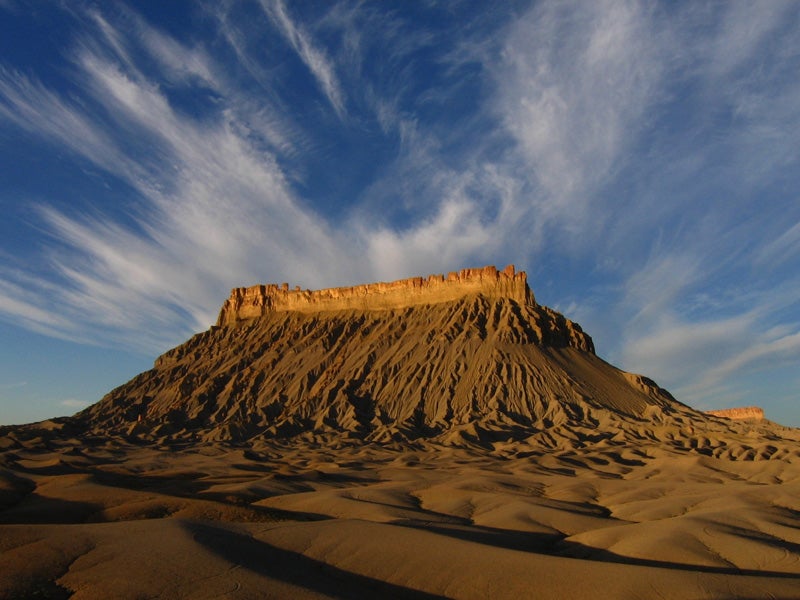Utah Court Protects Thousands of Acres of Scenic Land from ATV, Dirt Bike Riders
Earthjustice and the Southern Utah Wilderness Alliance recently won a court case that will force the Bureau of Land Management to minimize the impacts of off-road vehicles and to conduct detailed inventories of Native American cultural sites on over 2 million acres of scenic public lands.

This page was published 10 years ago. Find the latest on Earthjustice’s work.
On Bureau of Land Management (BLM) lands sandwiched between Utah’s Capitol Reef and Canyonlands National Parks, rivers wind past red rock spires and arches that seem as if they were carved by alien hands rather than the forces of wind and water. Here, a maze of canyons once sheltered Butch Cassidy and the Sundance Kid from the law, and the Henry Mountains became the last mountain range to be added to the map of the lower 48 states.
These striking wilderness landscapes have become icons of American geography, but until recently they were threatened by a spiderweb off-road vehicles—ATVs, dirt bikes and four-wheelers – that wreaked environmental havoc on the fragile soils, vegetation, water and wildlife of the area.
Thanks to Earthjustice litigation, the BLM must now conduct comprehensive environmental and cultural surveys before deciding whether to designate dirt roads and trails in this area for off-road vehicle use. Prior to the ruling, the BLM had set aside 4,200 miles of trails for these vehicles—almost enough for a round trip from Los Angeles to New York City—as part of their Richfield Resource Management Plan without following legal requirements to “minimize” impacts or survey for cultural sites.
“BLM has been ignoring its mandate to minimize environmental harm from off-road vehicle abuse since the Nixon administration, when the rules took effect,” said Robin Cooley, the lead Earthjustice attorney on the case. “The court’s strict deadline is a wake up call that will finally force BLM to do its job and protect this magnificent expanse of scenic redrock country.”
The Richfield plan, and five other plans that emphasized oil and gas drilling and motorized use to the detriment of spectacular redrock lands in Utah, were finalized in the Bush administration, but unfortunately vigorously defended by the Obama administration. All the plans were roundly criticized by local and national media, including the Salt Lake Tribune and the New York Times and by conservation groups since their release in 2008. A coalition of ten conservation groups led by Earthjustice, the Southern Utah Wilderness Alliance and The Wilderness Society, all played a pivotal role in convincing the court to reject the Richfield plan, which should impact the court’s review of the remaining five plans.
Over BLM’s complaints that it would take 15-20 years to comply with the law, the court’s decision requires that the BLM complete its analysis and surveys in three phases, with the first one to be complete in one year and the remaining phases in years two and three. This analysis must demonstrate that any off-road vehicle designations are designed to minimize impacts to wildlife, non-motorized recreation and other environmental values. It also requires an intensive cultural survey of the area, which is rich in archaeological sites and Native American history. Finally, the ruling requires the BLM to reconsider its decision not to protect the Henry Mountains an Area of Critical Environmental Concern—a designation that would increase protection of bison herds and large expanses of wilderness. The BLM must also revisit its refusal to classify Happy Canyon and portions of Buck and Pasture Canyons as areas eligible for protection under the Wild and Scenic Rivers Act.
“This important decision flatly rejects Utah BLM’s ‘designate trails first, think later’ approach to off-road vehicle management,” said Stephen Bloch, legal director for the Southern Utah Wilderness Alliance. “Utah’s remarkable redrock landscapes demand better.”
The Richfield plan is one of six BLM management plans in the eastern half of Utah that collectively cover more than 11 million acres of federal public land. The court’s decision raises legal questions about the remaining plans, which are also part of the litigation and which all suffer from the same legal flaws as the Richfield plan.
“The BLM should stop seeking to avoid its responsibilities and move forward with addressing the serious flaws in these six plans,” said Nada Culver, senior counsel for the Wilderness Society.
The district court’s decision draws attention to the importance of protecting Utah’s cultural and environmental resources and points out the need to address legal flaws in the remaining land use plans. This culmination of years of litigation is a huge victory for Earthjustice, the Southern Utah Wilderness Alliance and other members of the coalition that fought for Utah’s wildlands. It’s a win that demonstrates the power of conservation groups to bring about significant legal change. Now it’s time to tackle the next five BLM plans.